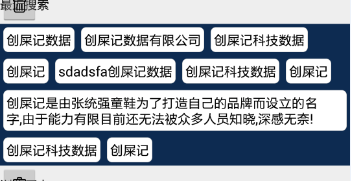本文引用了http://blog.csdn.net/gesanri/article/details/48968803博客的代码,并在其基础上修改了一些不足之处。
主要体现在单个内容过多的情况,会出现过多的内容换行时换了多次(根内容行数有关),并且,设置了margin后太长的内容会在宽度上超出屏幕。
将修改好的代码分享如下:
import java.util.ArrayList;
import java.util.List;
import wintime.jzx.R;
import android.content.Context;
import android.graphics.Color;
import android.util.AttributeSet;
import android.view.View;
import android.view.ViewGroup;
import android.widget.LinearLayout;
import android.widget.TextView;
/** 瀑布流布局
* @author 张统强
* @version 创建时间:2016-9-22 上午8:54:09
*
* 用法:xml中像添加普通View一样添加当前自定义控件.
* 代码中使用如下:
* private String[] tags = new String[]{"创屎记数据","创屎记数据有限公司","创屎记科技数据","创屎记",
* "sdadsfa创屎记数据","创屎记科技数据","创屎记","创屎记是由张统强童鞋为了打造自己的品牌而设立的名字,由于能力有限目前还无法被众多人员知晓,深感无奈!",
* "创屎记科技数据","创屎记"};
*
* oncreate方法中如下:
* MyFlowLayout flow = (MyFlowLayout) findViewById(R.id.flowLayout);
for (int i = 0; i < tags.length; i++) {
TextView tv = new TextView(this);
tv.setText(tags[i]);
tv.setTextColor(Color.BLACK);
LinearLayout.LayoutParams params = new LinearLayout.LayoutParams(
LinearLayout.LayoutParams.WRAP_CONTENT, LinearLayout.LayoutParams.WRAP_CONTENT);
params.setMargins(10, 10, 10,10);
tv.setLayoutParams(params);
tv.setMaxWidth(com.SCREEN_WIDTH - 20);//这句话是为了限制过长的内容顶出屏幕而设置的
tv.setPadding(10, 10, 10, 10);
tv.setBackgroundResource(R.drawable.rund_bg);
flow.addView(tv);
}
*
*/
public class MyFlowLayout extends ViewGroup {
private List<int[]> children;
public MyFlowLayout(Context context, AttributeSet attrs) {
super(context, attrs);
children = new ArrayList<int[]>();
}
@Override
protected void onMeasure(int widthMeasureSpec, int heightMeasureSpec) {
super.onMeasure(widthMeasureSpec, heightMeasureSpec);
measureChildren(widthMeasureSpec, heightMeasureSpec);
final int count = getChildCount(); // tag的数量
int left = 0; // 当前的左边距离
int top = 0; // 当前的上边距离
int beforeBottom = 0;//上一个控件的下边距.
int totalHeight = 0; // WRAP_CONTENT时控件总高度
int totalWidth = 0; // WRAP_CONTENT时控件总宽度
boolean isHH = false;//是否换行
for (int i = 0; i < count; i++) {
View child = getChildAt(i);
LinearLayout.LayoutParams params = (LinearLayout.LayoutParams) child.getLayoutParams();
//当前child的高度
int curH = params.topMargin + child.getMeasuredHeight() + params.bottomMargin;
if (i == 0) { // 第一行的高度
totalHeight = curH;
}
// 换行
if (left + params.leftMargin + child.getMeasuredWidth() + params.rightMargin > getMeasuredWidth())
{
left = 0;
// 每个TextView的高度都一样,随便取一个都行
isHH = true;
top = beforeBottom;//将上一个控件的底部位置赋值当前控件的顶部
totalHeight = top + curH;
}
//取当前高度跟之前值中的最大值
beforeBottom = Math.max(curH,beforeBottom)+((isHH)?curH:0);
isHH = false;
children.add(new int[]{
left + params.leftMargin,
top + params.topMargin,
left + params.leftMargin + child.getMeasuredWidth(),
top + params.topMargin + child.getMeasuredHeight()});
left += params.leftMargin + child.getMeasuredWidth() + params.rightMargin;
if (left > totalWidth) { // 当宽度为WRAP_CONTENT时,取宽度最大的一行
totalWidth = left;
}
}
int height = 0;
if (MeasureSpec.getMode(heightMeasureSpec) == MeasureSpec.EXACTLY) {
height = MeasureSpec.getSize(heightMeasureSpec);
} else {
height = totalHeight;
}
int width = 0;
if (MeasureSpec.getMode(widthMeasureSpec) == MeasureSpec.EXACTLY) {
width = MeasureSpec.getSize(widthMeasureSpec);
} else {
width = totalWidth;
}
setMeasuredDimension(width, height);
}
@Override
protected void onLayout(boolean changed, int l, int t, int r, int b) {
final int count = getChildCount();
for (int i = 0; i < count; i++) {
View child = getChildAt(i);
int[] position = children.get(i);
child.layout(position[0], position[1], position[2], position[3]);
}
}
}
改了主要部分的代码。不足之处还望指出。其效果运行起来如下:























 2万+
2万+

 被折叠的 条评论
为什么被折叠?
被折叠的 条评论
为什么被折叠?








